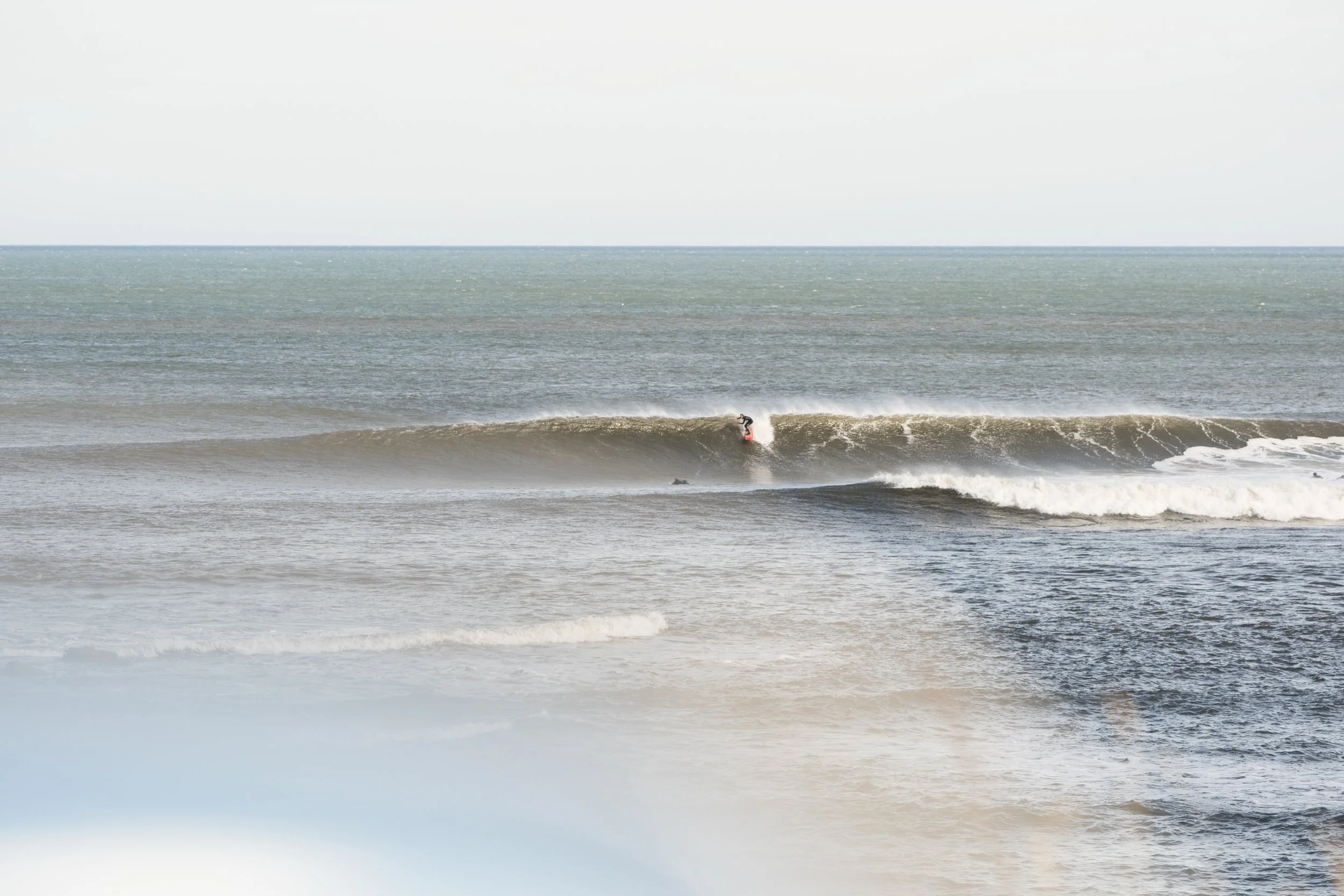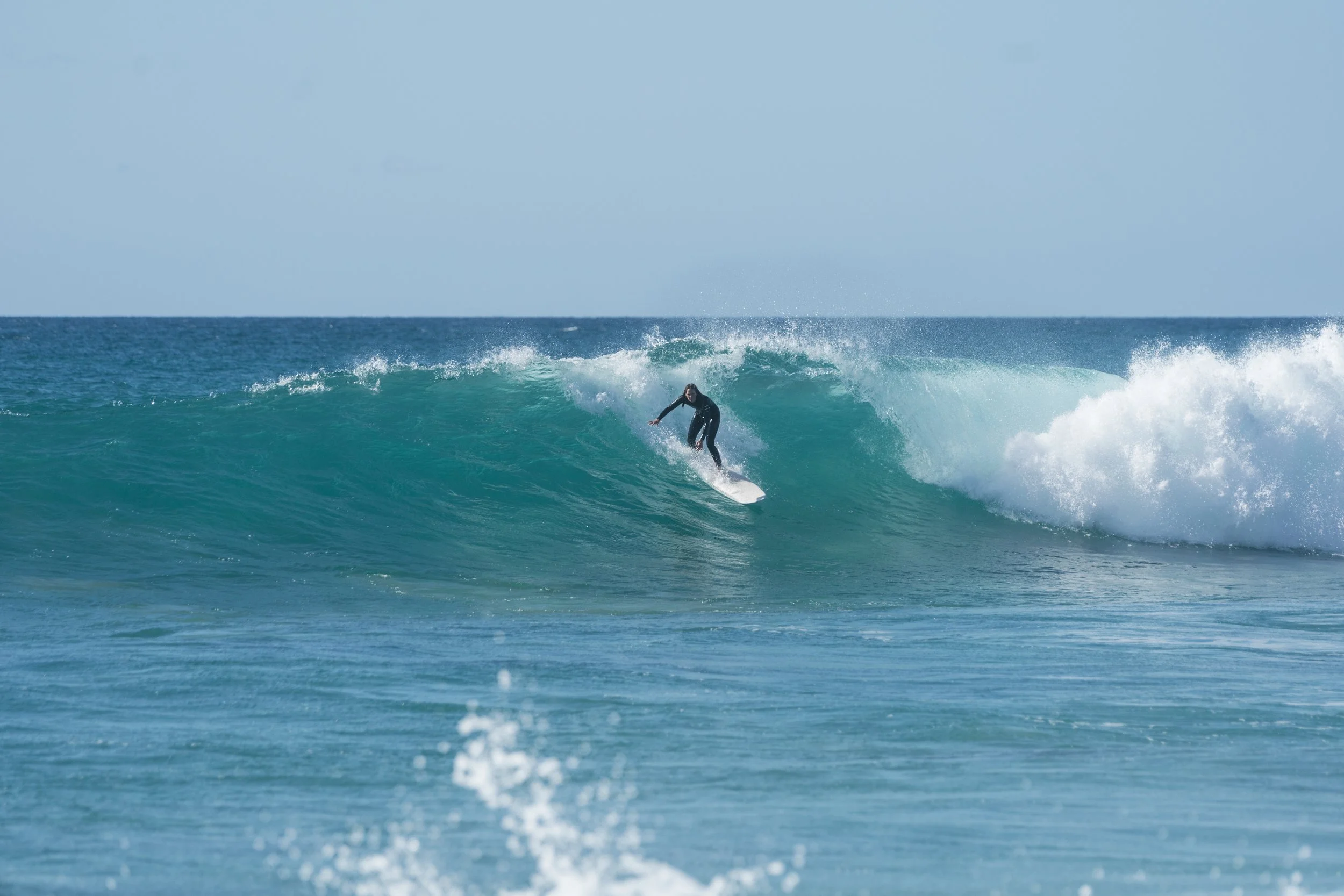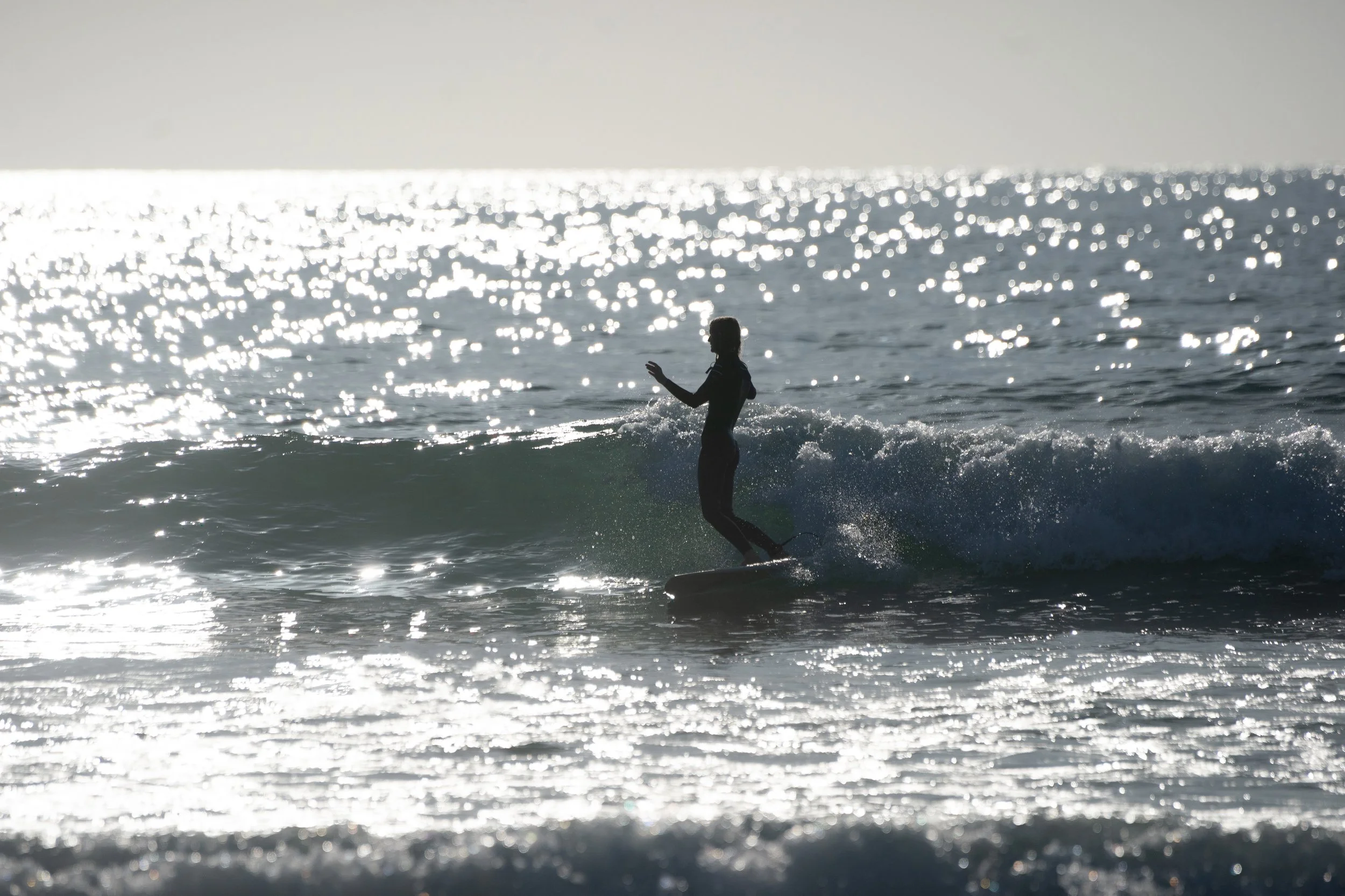Board talk - Midlengths
Most of us start our surfing journeys on a mini mal or a foamie, in and around the 7’6 to 8’ range. Given that a (good) mini mal is designed around two features; wave catching and ease of surfing, why don’t we stay on a mini mal forever?
Well, usually what happens with surfers is that we develop enough skill at surfing to where a mini mal actually becomes quite challenging to surf, or doesn’t support our needs. As our skills, experience and desires develop as surfers, we start to want to experiment and push our surfing to new places. Be that in smaller waves perhaps as longboarders; using our full boards to surf nose to tail in a traditional way, or perhaps in slightly bigger or steeper waves where we might want to be able to surf more critically. Either way we are often responding to and emulating surfing that we see around us, our peers in the water and on film, magazines, social media in both our body movements and the equipment we choose to use.
Today we are talking about midlegths, we’ll re-visit this blog from an alternative longboard viewpoint later on.
If we are looking to surf slightly faster waves and start to turn a little more critically on the face of the wave, the width and stability of a mini mal can become a burden. The way a mini mal works is that the size, width, rocker and bouyancy act to dull the feedback we put into our board. This is great if that feedback is us learning to surf and making small mistakes in technique; that’s exactly why they are forgiving and great for learners. For example if you are slightly too far forwards or back on your board, foot slightly in the wrong position, bodyweight too forward or backwards, arms, shoulders etc temporarily putting weight over the wrong part of the board in the pop up or steadying our balance, a mini mal and even more so a foamie doesn't pick up on this feedback so loudly and therefore largely allows us to recover and carry on surfing the wave. A high performance shortboard won’t forgive any of these mistakes in movement, they will respond to that feedback.
If we want to surf more actively and in more critical situations, we need a board that will respond to feedback a little more effectively, just the right amount. Is a midlength a beginners board? In short, no. It is easier to surf than a shortboard or a fish, yes. But you depending on how you surf or want to surf, you would struggle to find the upper performance limits of a refined egg. We will always have one in our quiver for those perfect egg days.
Three midlegths or ‘eggs’ after a surf in Morocco this year.
There are a myriad of different surfboards out there that all do different things. I personally cherish the fact that I feel the weight of history and culture and aesthetics heavy on my shoulders when I am considering a new surfboard. I start off with imagining a wave that I want the perfect board for and I imagine how I want to surf that wave and work from there. Often for me, that isn’t hacking and slashing; my favourite surfers to watch and to try to emulate in my head (it doesn't matter what it looks like; it’s in my head) are sympathetic to the wave, light of foot, surf with knowledge of a wave and mastery of movement.
They are often the people that I watched during the formative years of really becoming a surfer through films like One California Day, Dear and Yonder, The Seedling, The Sprout, The Present, Morning of the Earth. Joel Tudor, Tyler Warren, Alex Knost, Micheal Peterson, Chris and Keith Malloy, Devon Howard, Kassia Meador, Prue Jeffies, Belinda Baggs and the people around me at the time, Mark Dickinson, Steve Crawford.
When we started surfing, it was a pretty weird time in the industry, shortboard was king, shops were also packed with a lot of performance longboards. There was not a lot of ‘logging’. There was a lot of machoism attached to how small you could go with your shortboard, everyone rushing to get onto a high performance shortboard quickly it seemed. In the middle, between shortboards and longboards were a lot of Surftech and Tufflite weird boards, big wide nosed plasticky things, ‘big guy’ shortboards they were called. Anything that wasn’t a longboard or a shortboard was called a ‘fun board’. No foamies though; only surf schools had foamies, you couldn’t buy one in a shop at that time. Mini mals, yes, and Bic and NSP were still the big things the shops would push to beginners.
In the beginning everyone rode longboards, the transition era (67-69) was the era where surfers were starting to lose length and a lot of the egg and mid length shapes we are seeing today are heavily influenced by that time in history, combined with some of the knowledge developed since then. We’ll not get into displacement hulls here, maybe another day…
People in surfing always hark back to history, key players in what I would consider to be the alternative surfing movement; the movement that shunned the ASP and WSL looked at surfers like Dave Rastovich who had turned his back on that life, instead choosing to pave the way for freesurfers. He had largely shunned the thruster and was riding fish, Joel Tudor was riding fish, Prue Jeffries, early Ryan Burch footage. Anyone who wasn’t trying to look like they were straight out of a Quicksilver catalogue would largely ride a fish at that point in time. The term midlength didn’t really exist for many years, the boards were out there amongst the alternative surfing crowd but they were called eggs and were a throwback thing. Now the egg is the staple not only of the alternative crowd, but every YouTuber and surf shop owner is pushing versions of them from the big brands. I think every global surfboard company has a midlength offering in their main roster as of about 2020 or 2021 - not a bad thing, they work.
Eventually the high performance shortboard bubble seemed to burst, people got frustrated with being on shortboards too small for them. So the boards started to get wider and wider in the surf shops; the hybrid or groveller was born. The industry got behind them, sub 6’ and wide, usually five fin boxes. These were supposed to be easier to surf in weaker waves. Personally, I grabbed a log or an egg, I like the effortless glide of a longer board than having to be really active on a shortboard in a small wave. This period was maybe the advent of ‘litres’ in the surf industry. Trying to explain to someone who’s always ridden a 6’0 that they can ride a 5’6 now because it had more foam needed a metric; that metric was litres. It used to be just length x width x thickness.
Rach Parkinson on another slice of North African beauty. ~Visionary Surfboards Egg.
I had a 7’ hand shaped Chris Jones single fin egg which I still have, it’s from the mid 90’s and has largely formed my argument as to why a well made PU/PE board actually has a lower environmental footprint than something that is going to break, go out of fashion or lose its feel in a couple of years. Most people thought that board was a mini mal around here. I remember asking Matt Ayre who was shaping boards for us at the time to make me a sub 6’ board to travel with. I told him I wanted it to feel like my 7’, he said that the only thing that is going to make that board feel the way it does is the length of it, and 7’ can’t be replicated in a sub 6’ board. The rail line and length dictate the way it paddles and turns and holds and feels. Back to the drawing board.
I can pinpoint the time when ‘midlengths’ started to arrive in mainstream surf culture, I think it was around late 2019, early 2020 when Devon Howard started working with Channel Islands on the CI Mid. Perhaps that and the lockdowns and people realising wave count was important to them was the catalyst to the whole industry rushing to make a midlength model. Or maybe it was Torren Martyn riding Morning of the Earth surfboards which are still hand shaped and so hard to get hold of that the industry responded and focussed their efforts on selling the midlegth dream.
So anyway, history lesson over. We are here; a world where the midlength is recognised, for the record, we would have been reccomending people eggs way before the big shops would.
Here is where a lot of years of experimenting and dreaming took me, 6’8 x 20 3/4 x 2 3/4 x volume unknown. POG by Cooper Surfboards, Singlefin double stringer, polished. This is a ‘once in a lifetime’ board.
7ft singlefin egg.
6’10 Beau Young Wombat II
I am going to refer to these boards as eggs, although for SEO purposes I should keep calling them midlegths probably. An egg to me is somewhere between 6’6 and just under 8’. Its got a single fin box and can have side bites too. An egg should look smooth to the eye, balanced and smooth and subtle. Nothing wild about it. It should have subtle blend of 50-50 rails to a slightly sharper release at the fin, it should carry a little volume under the chest and I think it should be glassed heavier than a shortboard. It should have a subtle, lower rocker than a shortboard, single fin or 2+1. To be ridden without a tail pad.
If you are looking for the next step to a mini mal, an egg is a really great option, coming off a 7’6, on to a 6’10 - 7’2 egg is probably going to be a really great choice to open up a new world of surfing to you. An egg is a beautiful board to surf, sharp turning off the tail, unrivalled speed from the middle; its an active form of surfing, back foot constantly on the move between trim in the centre to stepping back over the fin to turn. It can’t be hacked or slashed, it has to be surfed sympathetically, yes, you can surf it powerfully but it has to be sympathetic to what the waves is presenting in front of you. Shortboards are great for fitting round pegs into square holes; that’s what they are designed to do. These boards have blown up and I’ve seen a lot of shortboard guys getting them and selling them again; it’s a different style of surfing, it isn’t high performance surfing of the ‘thruster mindset’. They are often popular with long boarders as an option to open up new waves and ways of surfing them.
We have been helping a lot of our community with boards and most of them are loving the egg shapes; we rarely find that our clients or community are interested in hacking and slashing waves to pieces and want to surf with style, flow and grace. At the same time as wanting to catch waves, make drops and feel manoeuvrable in trim.
How an egg feels.
So, should you get a mid length?
If you are more than comfortable on a mini mal, you can feel that you want to start to be a little more active on your board, you like the more soulful, flowing style of surfing and want to start pushing your surfing into new directions. Perhaps you are starting to travel or you enjoy travelling and want something a little more compact.
Perhaps you are building your quiver and getting a midlength means that you can get more specific with you boards, ie. get a more traditional style log for small clean days and an egg for the bigger days, that way you don’t have to try to compromise with a one board quiver.
There is also a big movement currently for twin pins, ridden longer than a traditional shortboard. I think a lot of these trends and fashions in surfing are cyclical but I think the desire to get into waves a little earlier and have a longer rail line particularly in hollower waves are fairly universal desires, will they stick around or not? That’s yet to be seen. Envision your favourite wave, your perfect surfing, what board is going to support that?
Either way, don’t get suckered into the marketing, support a decent shaper, look what your favourite surfers are riding, look at the shapers surfer run independent shops are using. Don’t forget that an off the shelf board is designed for convenience for a shop; the paid reviews, marketing budgets etc are there to channel the money to the one or two huge companies who dominate markets. Support creativity, support surf culture.







